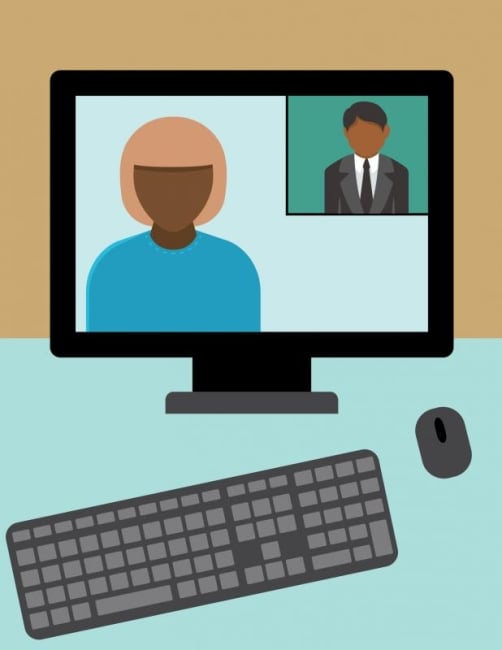You have /5 articles left.
Sign up for a free account or log in.

Diane555/digitalvision vectors/getty images
In the midst of the COVID-19 pandemic of 2020, faculty members have been forced to move to online pedagogy, many with little or no preparation. They must now teach using Zoom, Google Meet and other software. While this technology provides opportunities for instructors to engage student learning in the midst of a global crisis, they are finding challenges with the platforms.
A number of articles and online postings have begun to emerge addressing concerns about teaching with video software and students’ use of cameras. Many of the commentaries articulate a discomfort on the part of instructors when students do not turn their cameras on during synchronous class sessions. Consciously or unconsciously, the need to have cameras on -- while considered by many instructors as pedagogically sound -- is actually indicative of an attitude toward teaching that positions students as docile bodies in need of constant surveillance.
This pandemic undoubtedly makes all of us feel uncomfortable and out of control in many different ways. Searching for the familiar is a common approach to coping with these uncertain times. Staring at an empty box or just a name seems to make many instructors uncomfortable, yet feeling such discomfort does not give them the right to demand entry into students’ private spaces.
Many people seem to believe that turning cameras on is a pedagogical necessity and indicates more engaged students. They assume that seeing students’ faces during distance learning is a sign of participation and, conversely, that cameras off is an indication of disengagement.
Certainly, the concerns that instructors have about legitimate participation of their students in an online classroom are valid. But the ideologies of “cameras on” are incredibly problematic due to their racist, sexist and classist undertones. In this essay, we highlight and challenge the pathologizing of students that undergirds an instructor’s necessity for cameras on, and offer alternative views that center empathy, flexibility and trust.
Why It’s a Problem
Some instructors encourage students to turn their cameras on, while others penalize them for having their cameras off. Both approaches are an attempt to exert control over the bodies of their students, and few people question the premise that having cameras on is a necessary requirement for participation. Yet a cursory search of the literature shows research relating to communication, technology and the use of cameras as data-gathering tools but none on the necessity of cameras for learning or engagement. And, in fact, the added anxiety for some students who are asked to turn their cameras on may actually diminish their participation, as they feel a need to monitor their home, their family members and their intimate spaces while attempting to attend to classroom interactions.
Requesting or requiring students to let you inside their homes and private spaces can be culturally insensitive and ultimately racist. Students have the right to control their presentations of self and their intimate spaces. Demanding cameras on protects white racial privileges and traditional Western hierarchies of culture.
Why? Because, even in face-to-face settings, traditional markers of engagement are highly cultural. For example, maintaining eye contact as a sign of respect or engagement is a norm that some cultures do not practice. Instructors should not demand the right to claim unrestricted visual ownership of students’ bodies and spaces. Asking students to allow you into their private spaces potentially has significant cultural implications. Many students’ homes may have cultural artifacts and spaces that students do not want to share outside of their sociocultural groups.
Even assuming students have a space and technology that’s their own is classist. Cameras off may be a function of bandwidth as much as privacy. Multiple family members may need computer bandwidth in one household. Most important, students often share homes -- they may have children, partners, extended family members or pets that make them uncomfortable turning their cameras on.
Students may also have legal and protective reasons for not showing themselves or their family members on camera. Out of respect for their family and sometimes even for their safety, students do not turn their cameras on.
Being "camera ready" may be highly gendered, as well. For some women, the need to look a particular way may be important to their presentation of self in a public forum. They may feel that they need to dress, fix hair and apply makeup in order to be camera ready. With caregiving and other demands at home, this may prove particularly challenging. Thus, many women may decide to keep their cameras off, which instructors often incorrectly perceive as demonstrating they’re not academically engaged.
These are all critical equity issues that instructors should consider.
What Are the Alternatives?
For instructors, rather than focus energy on how to manipulate students to turn cameras on, we can concentrate on presenting the course content in ways that students can relate to. Some things to consider are:
- Lean in to the discomfort you may have about teaching online and examine it.
- Consider critical equity issues regarding race, gender and class when establishing your camera policy.
- Learn to trust in your students to be in charge of their own bodies, spaces and learning.
- Find ways to develop your virtual presence to show students that you are invested in their success.
- Offer alternative ways for students to demonstrate their engagement that don’t require cameras, such as using the chat function, organizing small group discussions and providing an online annotation tool for students to share their views.
The work of teaching requires the development of mutually respectful, trusting and supportive relationships. Respect and trust must extend to understanding students’ needs for privacy and the safety from surveillance of their private lives. At the same time, as professional educators, we must attend to student learning and proficiency. But learning and proficiency do not necessarily go hand in hand with a camera turned on.
We have multiple ways as instructors to create structures for students to demonstrate their learning. Rather than force old practices of face-to-face interactions into virtual spaces, each of us needs to understand the discomfort and demands that our students encounter when forced to turn cameras on.
The gaze of the classroom may become an impediment to engagement, and while looking at students may be comfortable to instructors, for students, it can be an alien experience. And it may also be an even greater block to learning.








